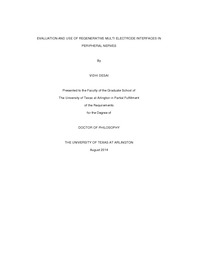
ATTENTION: The works hosted here are being migrated to a new repository that will consolidate resources, improve discoverability, and better show UTA's research impact on the global community. We will update authors as the migration progresses. Please see MavMatrix for more information.
Show simple item record
| dc.contributor.author | Desai, Vidhi | en_US |
| dc.date.accessioned | 2014-09-17T17:30:15Z | |
| dc.date.available | 2014-09-17T17:30:15Z | |
| dc.date.issued | 2014-09-17 | |
| dc.date.submitted | January 2014 | en_US |
| dc.identifier.other | DISS-12815 | en_US |
| dc.identifier.uri | http://hdl.handle.net/10106/24755 | |
| dc.description.abstract | Peripheral nerves offer unique accessibility to the innate motor and sensory pathways that can be interfaced with high degree of selectivity for intuitive and bidirectional control of advanced upper extremity prosthetic limbs. Several peripheral nerve interfaces have been proposed and investigated over the last few decades with significant progress made in the area of sensory feedback. However, clinical translation still remains a formidable challenge due to the lack of long term recordings. Prominent causes include signal degradation, eventual interface failures, and lack of specificity in the low amplitude nerve signals. This dissertation evaluates the capabilities of the newly developed Regenerative Multi-electrode Interface (REMI) by the characterization of signal quality progression, the identification of interfaced axon types, and the demonstration of "functional linkage" between acquired signals and target organs. Chapter 2 details the chronic recording of high quality signals from REMI in sciatic nerve which remained stable over a 120 day implantation period indicative of minimal ongoing tissue response with no detrimental effects on the recording ability. The dominant cause of failures was attributable to abiotic factors pertaining to the connector/wire breakage, observed in 76% of REMI implants. Also, the REMI implants had 20% higher success rate and significantly larger Signal to Noise Ratio (SNR) in comparison to the Utah Slanted Electrode Array (USEA). Chapter 3 describes the successful feasibility of interfacing with motor and sensory axons by REMI implantation in the tibial and sural fascicles of the sciatic nerve. A characteristic sampling bias towards recording signals from medium-to-large diameter axons that are primarily involved in mechanoception and proprioception sensory functions was uncovered. Specific bursting units (Inter Spike Interval of 30-70ms) were observed most frequently from the tibial fascicle during bipedal locomotion. Chapter 4 explores the discrimination between motor and proprioceptive origin of this bursting activity and reports the identified efferent motor nature, as well as the demonstration of a significant and stable correlation with the activity of distal muscle involved in locomotion. In summary, sensory-motor neural activity was recorded chronically by REMI electrodes with high SNR which serves as a tool for evaluating firing patterns of specific axon types during voluntary movement or sensory stimulation. In turn, this interface can be used to improve motor control and sensory feedback in closed loop systems for robotic prosthesis. | en_US |
| dc.description.sponsorship | Ortega, Mario | en_US |
| dc.language.iso | en | en_US |
| dc.publisher | Biomedical Engineering | en_US |
| dc.title | Evaluation And Use Of Regenerative Multi Electrode Interfaces In Peripheral Nerves | en_US |
| dc.type | Ph.D. | en_US |
| dc.contributor.committeeChair | Ortega, Mario | en_US |
| dc.degree.department | Biomedical Engineering | en_US |
| dc.degree.discipline | Biomedical Engineering | en_US |
| dc.degree.grantor | University of Texas at Arlington | en_US |
| dc.degree.level | doctoral | en_US |
| dc.degree.name | Ph.D. | en_US |
Files in this item
- Name:
- Desai_uta_2502D_12815.pdf
- Size:
- 6.536Mb
- Format:
- PDF
This item appears in the following Collection(s)
Show simple item record


